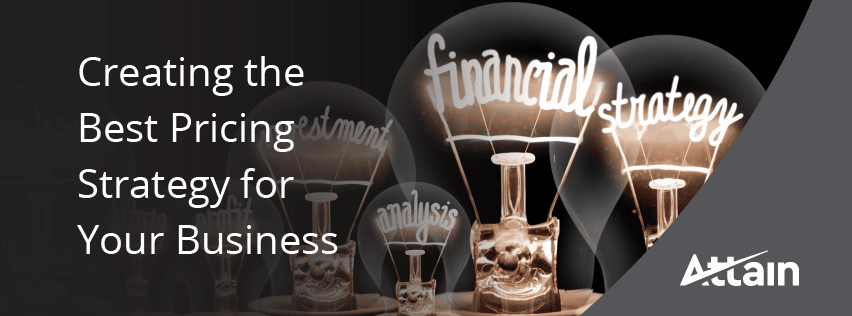Creating the Best Pricing Strategy for Your Business

To many people, a pricing strategy can seem scary; but it is essential for sustainable business growth.
Unfortunately, too many businesses don’t understand how to price their products or services correctly, which means they will change their pricing strategy later because it was not set correctly in the first place. Hitting the nail on the head with your pricing strategy the first time will save you heartache and lead to increased profit.
However, it is also worth re-evaluating your pricing strategy if your current profits don’t reflect the cost and effort you put into your goods/ services.
Table of Contents
What is a pricing strategy?
Pricing involves determining the value for a business exchanging its products and services. It should represent a fair value between the business and the client.
Determining how a business will charge for their products/services is a pricing strategy, something that looks different for every business.
Different types of pricing strategies can include:
- Premium – these are high prices, which tells potential customers you’re the best and they can expect high quality.
- Penetration – you could choose to go low, which can help secure market share quickly.
- Economy – this strategy focuses on low-cost products with slim margins and high volume.
- Skimming – new products/services are priced high and subsequently lowered as competitors enter the market.
As you can see, pricing is a complex issue with many considerations. Long-term factors consider profitability, while tactical pricing can consider short-term factors like demand shifts and competitive actions.
But don’t get too bogged down in the details; this can lead to missed opportunities or losing market share to competitors who change prices aggressively. However, if you focus too much on pricing tactics, you may not get the bigger picture and fail to develop long-term strategies that will bring you greater profits.
It’s not all about money
Having the right pricing strategy has the potential to improve people’s livelihoods as well as grow revenue and remain sustainable.
A consulting client we work with didn’t understand the value of his work, resulting in him quickly dropping prices in meetings with potential clients and underpricing his work.
His pricing strategy involved swapping time for money, which meant his clients often made serious returns while he was left underpaid and burnt out.
Attain worked with him to change his pricing strategy to a project-based pricing model. Once he understood his work’s impact on the client, he could set the value of the work to please both parties. The result was a 160% growth in revenue with a reduction in projects of only 20%.
Why?
Because he understood the value he created, what his market was willing to pay, and how to communicate with his clients effectively.
Cost is a key consideration
To effectively understand how to price, you must first understand what cost is.
In business, the cost is the value of the resources used to produce a finished product or service. This includes labour costs, equipment, materials, and infrastructure.
Every business incurs a cost when it provides a product or service to customers. When setting prices for products and services, businesses can control their expenditures and profit by keeping all costs in mind.
What should I consider when it comes to my pricing strategy?
- Costs: gathering financial information is the first step in pricing your products. This includes your fixed costs (expenses that remain the same no matter how many sales you make) and direct costs (what it costs to produce and deliver your goods/ services).
- Customer: keeping an eye on what your customers want from your products/ services is essential for success. Look into how much cost impacts their buying decisions and really take the time to get to know who your customers are.
- Competitors: do some research into your competitors’ pricing and offerings.
- Market Position: how you want to position yourself in the market will directly affect your price. A luxury brand will be priced differently from an economy brand.
- Profit: rather than basing your strategy solely around how much your competitors charge, you must ask yourself how much your time and expertise are worth. Decide carefully if your goods/services fit an hourly rate, project cost, or product price and keep in mind what the market is willing to pay.
Involve your CRO
Another essential aspect of a successful pricing strategy is your Chief Revenue Officer (CRO).
A CRO oversees every function that impacts revenue within a business and implements initiatives that improve business revenue streams.
This role combines the data and knowledge of all parts of the business and connects it to the market and ideal customer. A CRO understands the full effects of discounting and the impacts on reputation and profitability. They will know what the market is prepared to pay for your goods/services and how to capture the best value for both parties.
Conclusion
Once you’ve considered costs, market, ideal customer, value, and your CRO’s insights, you can create an effective pricing strategy that accurately reflects the value you provide to customers.
And if you don’t get it right the first time, try, try again!
If you’re looking for help setting your pricing strategy and driving your revenue goals, get in touch with Attain.

Sharn Piper – CEO
M: +64 27 733 4333
E: sharn@weareattain.com
Having successfully led numerous sales teams, built multiple successful businesses I know what it takes to create a sales process that is robust, repeatable and produces consistent results when applied in a consistent way.

